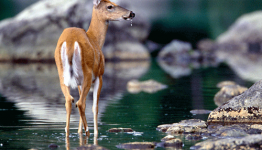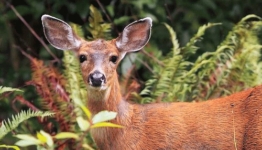 Deer are capable of living in a divers continuum of habitat out there. A few of them are able to live on the plains while others live in the tundra. It may interest you to know that there are deer species that inhabit the mountains as well as in the tropical rainforests. Lots of deer are likely to move back and forth between the open grassland and places where they can hide in the forests in a way that can blend into the background. Some even live in places you wouldn’t expect to see them like swampy area.
Deer are capable of living in a divers continuum of habitat out there. A few of them are able to live on the plains while others live in the tundra. It may interest you to know that there are deer species that inhabit the mountains as well as in the tropical rainforests. Lots of deer are likely to move back and forth between the open grassland and places where they can hide in the forests in a way that can blend into the background. Some even live in places you wouldn’t expect to see them like swampy area.
A deer may have about 30 square miles radius for their home range. “Herd” is the term given to a group of deer. The females will form a cluster that can comprise only a couple or quite a lot of them. Their progeny will join them too. The males are often alone except when they want to copulate. This is the only time you can find them close to the females group.
Although the females live in herds, they can be well distributed in an area. This explains why you may see a lone doe or with her fawn. It most likely that other females are around. Nevertheless, as a result of their ability to intermingle so well to the background it may be difficult to easily recognize their existence.
The males have a larger home terrain that they meander but they have to be cautious of other male counterparts. When the females meet they generally mind their without confrontation. Aggressive behaviors may result in the case of the males though when other males are in their region. This is the reason why it may be really difficult for the new young males that are seeking a place on their own.
In order to show that an area has been claimed, the males give off a strong scent in their natural habitat. They often tread heavily in the grass areas to discharge scent from their hooves. They will also wipe them on trees to achieve the same result. On their head, deer also have scent glands. They are able to release more of their scent by rubbing them on trees around.
All deer are very sincere to their given habitat. They won’t even relocate because farmers are bothering them. While they temporarily dash into secure locations because of hunters in the area they will definitely come back to those places. Even when their food is limited for their survival they will still not move on from the areas where they have recognized as their territory.
Deer seem to live healthy in confinement as long as their basic needs are provided. There are those reserved in zoos all over the world. Others are trained and grown for hunting operations. They may permit hunters to come on those lands or trade the mature deer so that they can be released and hunted in other places.
The major predicament for deer around is that their natural habitat is being taken away continually. For lots of species the places where they live keep on conflicting with where humans would like to possess. The equilibrium for deer and humans continues to be one very complicated.
Careful examination has revealed that deer are capable of adapting to many diverse types of habitat. However there is a limit to how quick and how frequent they can be anticipated to make changes. Lots of areas are now confined and these deer survive there. In some areas they are well contented and they won’t dash for safety when people approach either.
If you want your area free of deer today, try the Nature’s Mace Deer Repellent. Backed by numerous university studies, this all natural formula has more of the strongest ingredients found in nature.
The technology uses a unique three prong repellency which targets the deers sense of taste, smell, and fear. Specifically chosen organic ingredients, also fertilize your your yard as a dual action repel and revive system. Click here to try a proven effective deer repellent!











